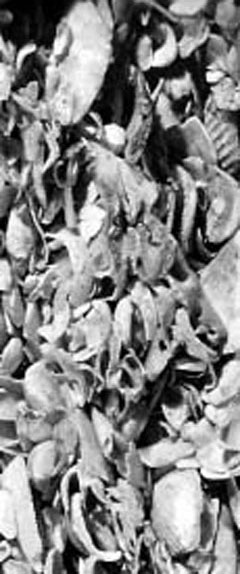
 |
de Steensplinter — Geology and a cosmology of the obvious | 4.4 groundwork |
 • Coquina deposit. (from J. Arem, `Rocks and Minerals') note 13 Some call it a virtual record, as it only exists as an organic pattern (J.A. den Ouden). But people share their memories with others, write books and erect monuments, which last as a material record, long after they themselves have gone. And then we have the example of the honey bee, who also shares his memories with others. previous (website version 2.30 - august 2007) |
groundwork [continued] 1. preview 2. geology, a key to the past 3. some evidence 4. formation of a bivalve shell 5. causality 6. inorganic processes formation of a bivalve shell A geologist who studies a `section' (a stack of sedimentary layers exposed on a rock face or on the wall of a quarry, or penetrated by the drill) sometimes encounters a layer composed entirely of shell material, a so-called coquina. This layer may comprise entire valves and fragments of a bivalve species (Lamellibranchiate mollusc. (see left) During growth the living animal enlarges and thickens its outer valve by successively depositing new layers of shell material on the inside of the pre-existing valve, there where the non-alive shell touches the skin of the living mantle. The animal concentrates calcium-carbonate extracted from the sea-water, secretes it in some hydrated form through the mantle skin, and deposits it as a new layer on the inside of the shell. (see next page) As the animal grows each new layer of the shell will extend further outward. The process of growth of the animal results in the formation of the shell as a record of its having been there. Its growth results from the processes that sustain the animal as a living being. Nor should one ignore the meteorological conditions that permitted the animal to live where it did. And so on. In this instance the record is substantial. It is also a record of form, for each species is characterized by a specific shell shape. The process of lithification subsequently results in the preservation of this layer. The process of erosion or drilling results in its exposure to the observing geologist, who will conclude that the concentration of all this material in a layer is a substantial record of a process of transportation and a process of deposition. Because of his thought-processes, he will conclude that the animals had lived elsewhere. The fact that the geologist can figure out what the meaning is of all he observes results from his remembering what he has learned in his studies and from his subsequent activities as a practicing scientist. Memory is also a record, a record left by processes in his brain. I still do not know what kind of record that is. 13 continued |
| © 2007 - uitgeverij de Steensplinter - All rights reserved |